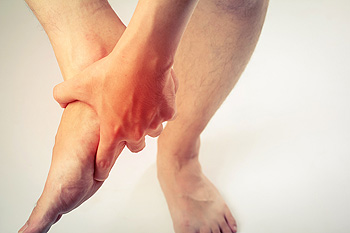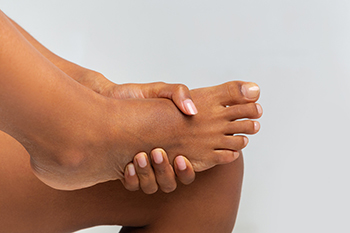
The most common complaint of heel pain is caused by plantar fasciitis. This overuse injury targets the band of connective tissue that runs along the sole of the foot, connecting the toes and heel. When the plantar fascia becomes irritated, it causes pain felt mostly under the heel. This inflammatory condition is caused by any activity that puts excessive force onto the bottom of the feet, such as running, jumping, or dancing. Being overweight, standing for long periods, or wearing shoes that lack ample cushioning are other common causes. Without treatment, the plantar fascia can become permanently damaged. Luckily, treatment for plantar fasciitis is generally successful. Resting and icing the feet is helpful, along with taking non-steroidal anti-inflammatory medication to reduce the pain. Other treatment options include wearing a heel cup or orthotic device in your shoes. Special exercises to stretch and strengthen the plantar fascia have brought relief from this condition when done regularly. If you are experiencing such heel pain, it is suggested that you consult a chiropodist for more information.
Plantar fasciitis can be painful and interfere with your daily activities. If you are experiencing foot or heel pain and believe you may be afflicted with plantar fasciitis, please consult with one of the specialists from Thornhill Foot Clinic. Our chiropodists will assess your condition and provide you with quality foot and ankle treatment.
What Is Plantar Fasciitis?
Plantar fasciitis refers to the inflammation of the plantar fascia, a ligament that runs along the bottom of the foot and connects the heel bone to the toes. Repetitive activities, such as running or jumping, can injure the plantar fascia over time. Plantar fasciitis can also be caused by flat feet, high arches, pregnancy, and activities that put excessive pressure on your feet, like standing all day for work. When the plantar fascia becomes inflamed, it causes pain and discomfort.
Symptoms
Typical symptoms of plantar fasciitis include:
Stabbing pain near the heel
Pain that is worst in the morning or after a period of rest
Pain that increases after exercising
Swelling
Tightness in the Achilles tendon
Diagnosis
Plantar fasciitis is typically diagnosed via medical history and physical examination.
Treatment
Treatments for plantar fasciitis include resting and icing the affected foot, stretching the foot, taking medications to reduce inflammation, and wearing orthotics. In severe cases where pain does not improve with conservative treatments, injections or surgery may be recommended.
If you have any questions, please feel free to contact our office located in . We offer the newest diagnostic and treatment technologies for all your foot care needs.





